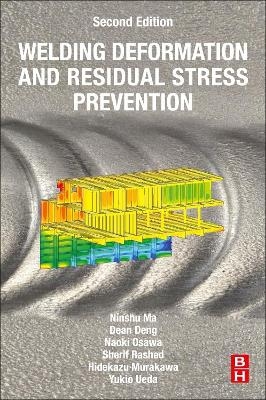
Welding Deformation and Residual Stress Prevention
Butterworth-Heinemann Inc (Verlag)
978-0-323-88665-9 (ISBN)
Destructive measurement techniques are covered as well, such as block cutting for releasing residual stress, blind hole drilling, deep hole drilling, the slit cutting method, sectional contour method, and general inherent strain method. Various industrial applications of the material behavior and computational approaches are featured throughout.
Ninshu Ma received his doctoral degree in Engineering from Osaka University in 1994 and then worked for 21 years as a professional consultant in the field of computer-aided engineering at Japan Research Institute. He’s currently a professor at Joining and Welding Research Institute, Osaka University. His research focuses on the development of computing methods and their FEM software for analysis of multi-physical phenomena in joining and forming processes. Recent work has centered on thermal-mechanical coupling analysis on various joining processes of dissimilar materials as well as additive manufacturing processes and the assessment of structural components. Dean Deng currently serves as full professor at College of Materials Science and Engineering, Chongqing University, China. He specializes in thermal-metallurgical-mechanical behaviors of materials during welding processes and is recognized for his research related to the development of advanced computational approaches for welding and joining process simulations, welding residual stress, and deformation. He has published more than 150 papers in peer-reviewed journals and conference proceedings and his papers have been cited over 4000 times. Naoki Osawa is Professor, Department of Naval Architecture and Ocean Engineering, Division of Global Architecture, Graduate School of Engineering, Osaka University. Prior to that he was Visiting Professor, Department of Civil Engineering, The University of Sydney, Australia. His principle fields of research are fatigue strength of ship structural materials, anti-corrosion technologies for ship structures, and ships and offshore platform fabrication techniques. Sharif Rashed was Professor, Joining and Welding Research Institute, Osaka University, Japan, from 2005-2019. His current roles are Owner and Consultant at Computer Aided Engineering Laboratory, Hyogo, Japan, and Advisor, Sumimoto Rubber Industry R&D Ltd., Japan. He has published more than 150 papers on structures, continuum mechanics, ultimate strength of structures, collision and impact, cracking and tearing, fluid structure interaction, and welding.
1. Introduction to welding mechanics 2. Introduction to measurement and prediction of residual stresses with the help of inherent strains 3. Mechanical simulation of welding 4. Computing methods of welding thermal-mechanics 5. Residual stress in typical welded joints 6. Practical analysis method for welding deformation of structures 7. Prediction of structural welding deformation and its mitigation 8. Analysis of additive manufacturing residual stress and deformation 9. Strategic analysis of welding residual stress for assessment
| Erscheinungsdatum | 04.07.2022 |
|---|---|
| Zusatzinfo | 275 illustrations (25 in full color); Illustrations |
| Verlagsort | Woburn |
| Sprache | englisch |
| Maße | 152 x 229 mm |
| Gewicht | 750 g |
| Themenwelt | Technik ► Bauwesen |
| Technik ► Maschinenbau | |
| ISBN-10 | 0-323-88665-5 / 0323886655 |
| ISBN-13 | 978-0-323-88665-9 / 9780323886659 |
| Zustand | Neuware |
| Haben Sie eine Frage zum Produkt? |
aus dem Bereich


